 Karst territories cover more than 2700 km2 in Slovakia. From the morphological point of view, in mountain positions we have plateau karst (Slovak Karst, Muráňska Plateau, Slovak Paradise, Galmus), karst of massive ridges, horsts and combined fold-fault structures (Strážovské Hills), dissected karst of monoclinal crests and ridges (Low Tatras, Greater Fatra), and the karst of Klippen structure (Pieniny, Vršatské Klippen). Karst of travertine mounds and cascades occurs in basin locations (Dreveník, Bojnice, Bešeňová), as well as the karst
Karst territories cover more than 2700 km2 in Slovakia. From the morphological point of view, in mountain positions we have plateau karst (Slovak Karst, Muráňska Plateau, Slovak Paradise, Galmus), karst of massive ridges, horsts and combined fold-fault structures (Strážovské Hills), dissected karst of monoclinal crests and ridges (Low Tatras, Greater Fatra), and the karst of Klippen structure (Pieniny, Vršatské Klippen). Karst of travertine mounds and cascades occurs in basin locations (Dreveník, Bojnice, Bešeňová), as well as the karst 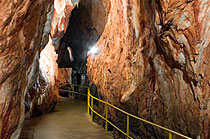 of isolated blocks and monadnocks, and karst of foothill plains and terraces. Karst of travertine mounds and cascades was sometimes formed in mountain positions (Hincava, Starohorská dolina, Revúcke podolie). In the central European temperate climatic zone, there is high-mountain karst in the highest positions above the upper tree line (Belianske Tatry, Červené vrchy v Západných Tatrách, Ďumbiersky kras v Nízkých Tatrách) with its geological structure determined by fold-fault or monoclinal structures. Cryptokarst, bound to lens-shaped formation of crystalline limestones in the basement of impervious rocks (Ochtiná cryptokarst in the Revúcka Highland), is of special character.
of isolated blocks and monadnocks, and karst of foothill plains and terraces. Karst of travertine mounds and cascades was sometimes formed in mountain positions (Hincava, Starohorská dolina, Revúcke podolie). In the central European temperate climatic zone, there is high-mountain karst in the highest positions above the upper tree line (Belianske Tatry, Červené vrchy v Západných Tatrách, Ďumbiersky kras v Nízkých Tatrách) with its geological structure determined by fold-fault or monoclinal structures. Cryptokarst, bound to lens-shaped formation of crystalline limestones in the basement of impervious rocks (Ochtiná cryptokarst in the Revúcka Highland), is of special character.
There are more than 8,100 caves in Slovakia including shorter caves of overhang character. The majority of registered caves is in the Slovak Karst, Low Tatras and Spiš-Gemer Karst (Slovak Paradise, Muráň Plateau), Greater Fatra, Western, High and Belianske Tatras.
Our caves are mostly formed in Mesozoic Middle Triassic Limestones, less in travertines and sporadically in other less soluble rocks. More than 180 caves are formed in non-karst rocks (andesites, basalts and their volcanoclastics, sandstones, quartzites, shales, quartz).
We have various types of caves from the genesis point of view. Syngenetic caves, formed at the same time with rock formation, are presented by travertine crater caves, caves of travertine constructive waterfalls, volcano-exhalation and volcano-explosive caves. Epigenetic caves, formed by geomorphic process after the formation of rock are represented by corrosive, corrosive-collapsed, fluviokarst (corrosive-erosive), fluviokarst-collapsed, crevasse, crevasse-collapsed, crevasse-corrosive, debris, weathered caves and others.
The largest system of the Demänovské Caves is more than 41 km long. It comprises the Pustá Cave, Demänovská Cave of Liberty, Vyvieranie Cave, Demänovská Cave of Peace, Demänovská Ice Cave and other less important caves. The deepest are the Hipman’s Caves (Starý hrad – Večná robota) in the Krakova hoľa in Low Tatras Mts., with vertical span of 495 m.
| Order | Name | Location | Length |
|---|---|---|---|
| 1 | Demänovský Cave System | Low Tatras | 41 133 m |
| 2 | Mesačný tieň (Moon Shadow) | High Tatras | 31 840 m |
| 3 | Stratenská Cave- Psie diery Cave | Slovak Paradise | 22 264 m |
| 4 | Dead Bats Cave | Low Tatras | 21 042 m |
| 5 | Štefanová Cave | Low Tatras | 14 740 m |
| 6 | Zlomísk Cave | Low Tatras | 10 668 m |
| 7 | Javorinka | High Tatras | 9 335 m |
| 8 | Hipmanove Caves | Low Tatras | 7 554 m |
| 9 | Skalistý potok (Rocky Brook) | Slovak Karst | 7 107 m |
| 10 | Domica – Čertova diera | Slovak Karst | 5 368 m |
| Order | Name | Location | Depth / vertical range |
|---|---|---|---|
| 1 | Hipmanove Caves | Low Tatras | 495 m |
| 2 | Mesačný tieň (moon Shadow) | High Tatras | 451 m |
| 3 | Javorinka | High Tatras | 374 m |
| 4 | Skalistý potok (Rocky Brook) | Slovak Karst | 336 m |
| 5 | Dead Bats Cave | Low Tatras | 324 m |
| 6 | Javorová Abyss | Low Tatras | 313 m |
| 7 | Cavev Záskočí - Na predných | Low Tatras | 284 m |
| 8 | Čiernohorský Cave System | High Tatras | 232 m |
| 9 | Kunia Abyss | Slovak Karst | 203 m |
| 10 | Demänovský Cave System | Low Tatras | 201 m |
| 11 | Tristarská Abyss | Belianske Tatras | 201 m |
The longest cave in travertine is Puklinová Cave Pleky, which is situated in Dreveník in Hornád Basin and reaches the length of 100 m. The longest caves of the Klippen structure is Aksamitka Cave (330 m) in Pieniny. The longest pseudokarst cave is Cave under Spišská (740 m) in sandstones of the Levočské Hills.
Caves with the highest elevation can be found in Červené vrchy Mts. in the Western Tatras. The Abyss Vyšná Kresanica is located in elevation of 2077 – 2080 m together with three smaller caves. The biggest cave with entrance above 2000 m is the Nová Kresanica Cave, which is 820 m long and 183 m deep. A karst cavern lying on horizon of 120 m above the sea was documented in underground magnesite deposit in Podrečany near Lučenec and other caves were uncovered by excavation in Bankov near Košice on the horizon of 50 m above the sea.
The most westerly situated cave is the Abrázna Cave in the Devín part of the Malé Karpaty Mts., which is a remain of coastal modelling by prehistoric Tertiary sea. The most easterly situated are Ďakova and Pustajova Caves in sandstones of the Bukovské vrchy Mts. in the territory of the Poloniny National Park. The most northerly situated are the caves in sandstones of the Babia hora Hill, the most southerly located are the caves in volcano-clastic rocks of the Burda Mts. between the mouth of Hron and Ipeľ into Dunaj River.
The biggest underground space is the Rozprávkový Dome in the Stratenská Cave with the length of 192 m, average width of 46 m, average height of 11 m, surface of 9,040 m2 and volume of 79,017 m3.The second largest space is the Bystrický Dome (volume of 52,000 m3, height of 40 m) in the Dead Bats Cave in the Ďumbier Karst.
 The longest stalagmite, 32,6 m long is in the Krásnohorská Cave, which is located in the northern part of the Silická Plateau in the Slovak Karst. The Domica Cave belongs among the most significant locations with occurrence of flowstone shields and drums in the world. The Gombasecká Cave is unique by occurrence of thin and fragile straw stalactites (soda straw). The largest layers of moonmilk are in the Harmanecká Cave.
The longest stalagmite, 32,6 m long is in the Krásnohorská Cave, which is located in the northern part of the Silická Plateau in the Slovak Karst. The Domica Cave belongs among the most significant locations with occurrence of flowstone shields and drums in the world. The Gombasecká Cave is unique by occurrence of thin and fragile straw stalactites (soda straw). The largest layers of moonmilk are in the Harmanecká Cave.
Ice fill occurs permanently or occasionally in more than 60 caves. Four of them were formed in travertine and four in non-karst rocks. From the climatogeographical point of view, the caves with ice fill are located mainly in areas with mountain cool, cold and very cold climate (84,8 %).
 The biggest volume of ice is in the Dobšinskej Ice Cave (more than 110, 100 m3), which belongs among the most significant ice caves in the world. In respect to the known high-mountain ice caves Eisriesenwelt and Dachstein-Rieseneishöhle in Austrian Alps or the Scărişoara Cave in Romanian mountains of Bihor, which has the glaciated part at elevation of 1100 to 1120 m, the monumental glaciation of the Dobšinská Ice Cave has been outlasting for several thousand years at elevation of only 920 to 950 m.
The biggest volume of ice is in the Dobšinskej Ice Cave (more than 110, 100 m3), which belongs among the most significant ice caves in the world. In respect to the known high-mountain ice caves Eisriesenwelt and Dachstein-Rieseneishöhle in Austrian Alps or the Scărişoara Cave in Romanian mountains of Bihor, which has the glaciated part at elevation of 1100 to 1120 m, the monumental glaciation of the Dobšinská Ice Cave has been outlasting for several thousand years at elevation of only 920 to 950 m.
Other significant caves with ice are the Demänovská Ice Cave, Veľká ľadová priepasť (Big Ice Abyss) in Ohnište in Low Tatras, Ľadová priepasť (Ice Abyss) in Červené vrchy and others. The cave with permanent ice fill lying at the lowest elevation is the Silická ľadnica Cave (entrance at 503 m) in the Silická Plateau in Slovak Karst.
The most important is lying in the cryptokarst Ochtinská Aragonite Cave in Hrádok in Revúcka Highland, discovered accidentally while drilling a geological survey adit in 1954. The cave ranks among the most valuable aragonite caves in the world by the plentitude and variability of aragonite fill forms.
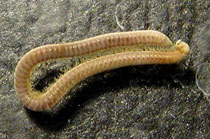 Several endemites and relics of terrestrial and water fauna occur in cave environment with specific ecological conditions. The biggest troglobite – genuine cave animal in our country was found in the Gombasecká Cave Gombasecká Cave and later in Domica Cave.. A blind multipede of genus Typhloiulus sp. (length of body 26 mm; body diameter 1,1 mm; number of trunk segments 77; number of leg pairs 147) is the first finding of troglobitic multipede in Slovakia. With the number of legs it is the most-legged animal of our fauna icluding surface multipedes and arthropods.
Several endemites and relics of terrestrial and water fauna occur in cave environment with specific ecological conditions. The biggest troglobite – genuine cave animal in our country was found in the Gombasecká Cave Gombasecká Cave and later in Domica Cave.. A blind multipede of genus Typhloiulus sp. (length of body 26 mm; body diameter 1,1 mm; number of trunk segments 77; number of leg pairs 147) is the first finding of troglobitic multipede in Slovakia. With the number of legs it is the most-legged animal of our fauna icluding surface multipedes and arthropods.
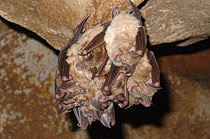 The biggest species occurrence of bats in Slovakia was determined in caves of the Jasovská Rock in the Medzev Upland, where as many as 19 bat species were found. Observation of 16 bat species is recorded from the cave system Čertova diera – Domica in the Slovak Karst.
The biggest species occurrence of bats in Slovakia was determined in caves of the Jasovská Rock in the Medzev Upland, where as many as 19 bat species were found. Observation of 16 bat species is recorded from the cave system Čertova diera – Domica in the Slovak Karst.
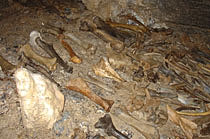 The caves with very rich osteological discoveries (bones of Pleistocene vertebrates) are: the Medvedia Cave and Psie diery Cave in the Slovak Paradise, Medvedia Cave in the Jánska Valley in the Low Tatras, Medvedia Cave in the Suchá Valley in the Western Tatras and in the Važecká jaskyňa.
The caves with very rich osteological discoveries (bones of Pleistocene vertebrates) are: the Medvedia Cave and Psie diery Cave in the Slovak Paradise, Medvedia Cave in the Jánska Valley in the Low Tatras, Medvedia Cave in the Suchá Valley in the Western Tatras and in the Važecká jaskyňa.
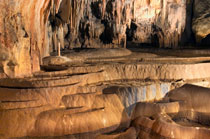 Important archaeological finding places are the Ardovská Cave, Babská diera, Domica, Majda-Hraškova Cave, Kostrová Cave (Slovak Karst), Jasovská Cave (Medzev Upland), Veľká ružínska Cave (Čierna hora), Šarkanova diera (Volovské vrchy Mts.), Liskovská cave (Liptovská Basin), Mažarná (Veľká Fatra Mts.), Dúpna diera (Strážovské vrchy Mts.), Prepoštská Cave (Prievidzská Basin), Čertova pec (Považský Inovec Mts.), Deravá skala a Tmavá skala (Malé Karpaty Mts.) and others.
Important archaeological finding places are the Ardovská Cave, Babská diera, Domica, Majda-Hraškova Cave, Kostrová Cave (Slovak Karst), Jasovská Cave (Medzev Upland), Veľká ružínska Cave (Čierna hora), Šarkanova diera (Volovské vrchy Mts.), Liskovská cave (Liptovská Basin), Mažarná (Veľká Fatra Mts.), Dúpna diera (Strážovské vrchy Mts.), Prepoštská Cave (Prievidzská Basin), Čertova pec (Považský Inovec Mts.), Deravá skala a Tmavá skala (Malé Karpaty Mts.) and others.
The oldest written mentions about a cave in Slovak territory from the years 1220 and 1224 are related to the Cave na Skalke (Benedikt’s Cave) near Trenčín. The oldest inscription from 1452 is in the Jasovská Cave.
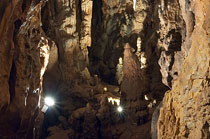 The first show cave in Slovakia was the Plavecká Cave in Malé Karpaty induced by the owner of the land – the count Pálffyho sometimes in 1802 – 1809. The Jasovská Cave was open for public by the Premonstratensian order in 1846. Dobšinská Ice Cave was opened for public in 1871, Belianska Cave in 1881. Demänovská Ice Cave started with development for public in the second half of the eighties.
The first show cave in Slovakia was the Plavecká Cave in Malé Karpaty induced by the owner of the land – the count Pálffyho sometimes in 1802 – 1809. The Jasovská Cave was open for public by the Premonstratensian order in 1846. Dobšinská Ice Cave was opened for public in 1871, Belianska Cave in 1881. Demänovská Ice Cave started with development for public in the second half of the eighties.
Dobšinská Ice Cave belongs among the first electrically lit caves in the world. They started to use Bunsen’s burners in 1882 and regular electric lighting in 1887.
The highest number of visitors has the Demänovská Cave of Liberty (155-thousand to 175-th. people). The most visited caves are: Belianska Cave, Dobšinská Ice Cave and the Demänovská Ice Cave.
The only show cave with underground boat ride for visitors is the Domica, which suffered by several catastrophic floods in the past. Protection measures are applied in its basin to prevent the cave from agricultural activities that can bring soil erosion and water pollution, which can easily enter the cave.
The only show cave in the western Slovakia is the Driny Cave in the Smolenice Karst in the Malé Karpaty Mts. In comparison with other show caves with bigger and wider underground spaces, it presents a system of narrower fissure corrosive passages, however with beautiful dripstone decoration.
Speleotherapeutical treatment is carried out in the Bystrianska Cave, healing speleoclimatic stays are in the Jasovská and Belianska Cave. The beginnings of the speleotherapy in Slovakia go back to the end of the sixties and beginning of the seventies and relate to the Gombasecká Cave. Balneotherapy is provided in the Parenica Cave in Sklené Teplice in the Štiavnické Hills – discribed already by M. Bel in 1723 as a steam bath.
44 caves and abysses are designated national nature monuments. The caves of the Slovak karst, Ochtinská aragonite Cave and Dobšinská Ice Cave with the system of Stratenská Cave are inscribed on the World Natural Heritage list. The Domica cave belongs among the underground wetlands of international importance of the Ramsar Convention. It is a part of a cross-boundary Slovak – Hungarian cave system Domica – Baradla. The Caves of the Demänovská Valley were included on the list of wetlands of international importance since 2006.
Protection, care and administration of caves as state ownership is carried out by the Slovak Caves Administration in Liptovský Mikuláš. The National cave database is developed and administered by the Slovak Museum of Nature Protecion and Caving in Liptovský Mikuláš, which is concentrated on collecting samples in relation to caves and cavers. New caves or parts of caves are discovered mainly by the members of the Slovak Speleological Society, and they cooperate in documentation and protection of caves.
Dear visitors, we would like to inform you that due to the technical conditions of payment terminals, there may be situations when card payment will not be possible. For this reason, we recommend that you have an adequate amount of cash available if you want to be sure that you will be able to visit the cave. Thank you for understanding.
Dear visitors, the parking lot doesn't belong to cave administration. The fees are collected by different entity. Thank you for your understanding.